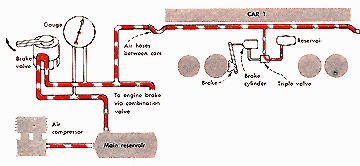This is of course not the only
brake system in use around the world, but it is the most common. The
other systems include the basic air brake sometimes used on tram
cars, the vacuum brake (also quite a comon system ) and several other
minor brake systems.
However as the automatic air brake is the
most comon, that is the one we will look at here. We are interested
in the brake from the point of view of the train driver, so lets
begin with the drivers controls and how they work.
|
On the right is the standard brake control which will be
familiar to almost every train driver, steam or diesel,
anywhere in the world. This particular example is a
Westinghouse L-8-PA Brake Valve from one of the American
railroads.
You will notice that it has two main control handles. 1)
Automatic Brake System, 2) Independant Brake System.
The automatic brake controls the air in the train pipe.
That is the pipe which runs the entire length of the train
connected between vehicles by flexible hoses.
The independant brake controls only the locomotive brakes
and is as the name implies independant of the train brakes.
It is important to understand at this stage why there are
separate systems. Let me give you an example to illustrate.
Lets say we are standing in a station and all the coaches
are bunched together at the couplings. If we just pulled
away the couplings would receive a hard snap as each one in
turn down the length of the train took up the slack .
|

|
Not only would this stress the couplings but
the passengers would recieve a very hard jolt as each coach pulled
away. It is therefore quite normal to release the locomotive
(independant) brake and then release the coach brakes gradually as
the slack is taken up. This ensures that none of the couplings become
overstressed and the passengers dont end up with their lunch in their
laps. We can also use this system of braking to prevent coaches from
bunching up on down hill gradients, when a small amount of braking
force applied to the coaching stock will certainly help.
There are very many situations and
conditions where brakes are used and it would be well beyond this
article to list them all but as you can now see brakes have other
uses than just stopping trains.
The Brake Controls
The brake controls have very specific method
of operation In this article it is only possible to outline these and
give a rough description of their function as follows:
|

|
The brake control positions are listed in the following
table and should give a good indication of how the brake
operates.
|
|
Release:
|
This position releases all brakes and charges the air
reservoirs as quickly as the compressor can supply the air.
|
|
Running:
|
This position also releases the brakes and charges the
reservoirs but at a slower rate. The reservoirs are charged
to a pre set pressure depending on the train weight.
|
|
First
Service:
|
This Position is used to apply brake increase action
gradually
|
|
Lap:
|
In this position the brake pipe pressure is maintained .
keeping the braking force at whatever level it has been set
at by service or first service.
|
|
Service:
|
Applies brake force more rapidly than first service.
|
|
Emergency:
|
Used only in dire emergency situations this will apply
full brake force and usually lock the wheels.
|
Links To Great Railway Web Sites (
including the one already mentioned where you have the chance to
drive trains)
Basic Stuff Introduction Plus How To Stop A
Train
How Diesel Railway Engines Work (This
Page Still Under Construction)
How To Drive A Diesel Mechanical Multiple
Unit
Back To Our Home Page


